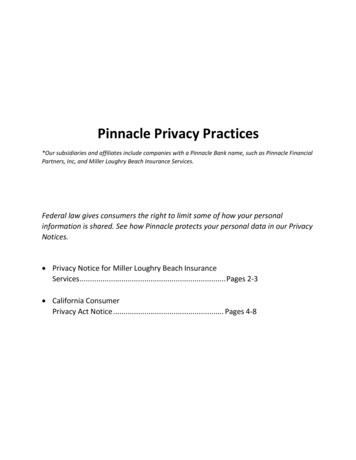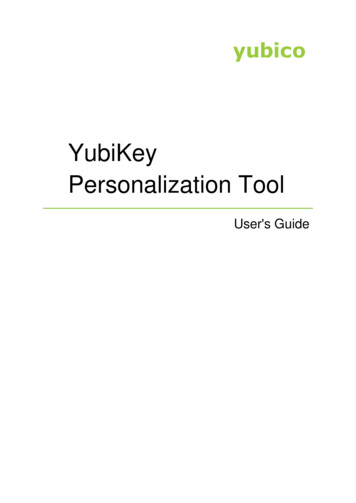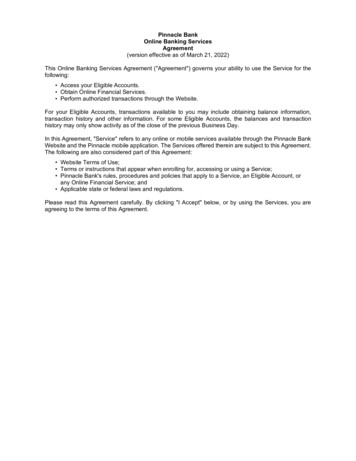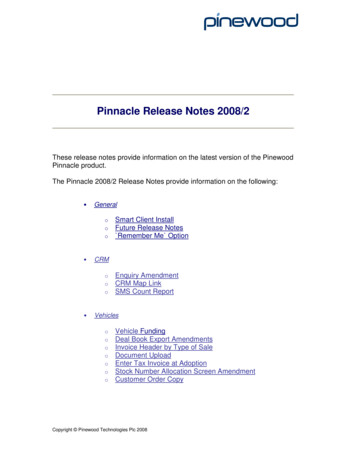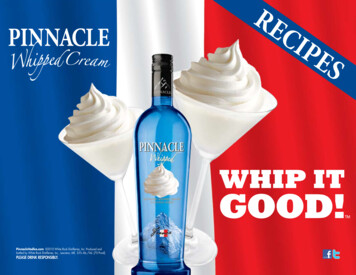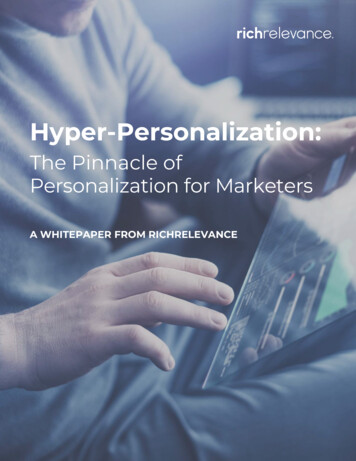
Transcription
!"# %&'('%)Hyper-Personalization:The Pinnacle ofPersonalization for MarketersA WHITEPAPER FROM RICHRELEVANCE
HYPER-PERSONALIZATION: THE PINNACLE OF PERSONALIZATION FOR MARKETERSTable of ContentsHyper-Personalization: The Pinnacle of Personalization for MarketersExecutive summary1Modern Digital Marketers Have A Dilemma2The Experience Gap and the Failure of Digital Marketing6Hyper-Personalization: The Missing Link in Personalization8#1 Hyper-Personalization: Individual, not just segments9#2 Hyper-Personalization: Real-time Context10#3 Hyper-Personalization: AI-driven Decisioning11Adding Value to Marketing Clouds13 And to Commerce Clouds15Why Choose RichRelevance17
HYPER-PERSONALIZATION: THE PINNACLE OF PERSONALIZATION FOR MARKETERSExecutive SummaryEvery business today, regardless of industry, knows its goods and services arebecoming rapidly commoditized. Competing and winning require differentiationthrough memorable “experiences” as the next evolution in the Experience Economy.[If you’re new to the topic, or want a refresher, we recommend taking a look at ourrecent co-authored whitepaper entitled, “It’s the (Experience) Economy, Stupid”,with Joseph Pine, Author, Speaker and Management Advisor.In that publication, we concluded by constructing a framework to deliver on thepromise of experience personalization: What is it, what would it potentially look like,the constituent parts of its platform, and how it would all work and fit together. Theintent of this paper is to take the next logical step and actually turn the model intoa proof of concept and demonstrate its practical application in use today, throughreal-world examples and use cases.Before we do that, though, we’re going to first need to explore the rationale for thatnew solution and how the unrelenting advance of technology has created a gap thatthe current commerce and marketing clouds can’t fill.We’ll look at the explosion of digital channels and how it’s made it extremely difficultif not budgetarily prohibitive for marketers to reach all of their audiences.We’ll examine the real problems business leaders face when attempting to usemarketing and commerce stacks -- built for one-way and transactional interactions-- to turn every cold digital exchange into a warm personal and more importantly, amemorable one.And finally, we’ll demonstrate the need for a bridge – an Personalization Cloud withHyper-Personalization, sitting in between marketing and commerce clouds. One thatnot only can consume and enrich marketing segments, learn from their applicationin context, and then export them back for even more targeted campaigns but alsoadd value to commerce, by exposing real-time product and behavioral data, toincrease average order value, per session revenue, and loyalty and overall customerlifetime value.The Experience Economy is here and is only going to become more entrenched astechnology advances. We’re soon heading to a world where almost every humaninteraction will have a digital component, and you can be sure that there will be acustomer expecting their preferred business to personalize for it. The only questionleft is, will you or your competition be the one to do it.1
HYPER-PERSONALIZATION: THE PINNACLE OF PERSONALIZATION FOR MARKETERSModern Digital MarketersHave A DilemmaThe explosion of digital channels and consumer behavioral changeshave put marketers in a difficult position. Customers now have somany ways to interact with your brand, it’s almost impossible to reachthem all and carry on a consistent, seamless conversation, given thelimitations of current marketing technology – and budgets. Sensing anopportunity here, there are now many contenders to try and solve thepersonalization puzzle, from marketing clouds to in-house solutions topoint solution providers.Let’s examine the most common issues that digital marketers facetoday.CUSTOMER INTERACTION CONTROL IS AN ILLUSIONLet’s face it. Marketers are control freaks, who need to pull the stringson every customer interaction. Up to now, they’ve been enabled bymartech that allowed them to carefully plan the customer journeyand define the exact path the customer ought to take, from channelto channel.The problem? Customers no longer want to be constrained by themarketers’ prescribed path nor are there marketing tools to carry theplans all the way down to execution.In the Experience Economy, customers are free to choose many paths- bounce from channel to channel and device to device – which throwsthe marketers plans straight out the window. The endpoint may be thesame, but with the proliferation of channels and ease with which onecan move between them, and choose the context, there’s no way for themarketer to know how or when the customer will actually arrive there.MORE IS NOT BETTERTo compensate, marketers have resorted to turning up the volumeon the channels (More offers! More content! Increase email sendfrequency!) they can control – using segmentation to push out more in2
HYPER-PERSONALIZATION: THE PINNACLE OF PERSONALIZATION FOR MARKETERSthe hope of reaching each customer with the right message at the righttime. But broad-based, probabilistic segments have their limitations.You can create all the propensity scores you want, but in the end, you’rejust gambling that what is right for a general persona is also correct fora specific individual, at a particular point in time and context.Bottom line: current marketing tools are channel- and segmentoriented, and do not offer an contextual approach towards theexecution of experience design.REAL TIME IS REAL IMPORTANTDigital marketing has come a long way in a short time and now includestools and analytics that allow you to fine-tune your campaigns downto the second. While having this capability is no doubt important anduseful, it doesn’t change the fact that the messages being deliveredare still just one-directional and completely blind and deaf to theindividual and context at the other end.Real-time contextual data opens a line of communication and windowinto the customers’ behavior and intent that can’t be approached with theinherent latency of the typical martech solution. It’s that immediacy thatprovides you the exact context of every individual interaction and allowsyou to deliver the exact best offer at the time of open, instead of the samemass blast to everyone in the segment, and hope something sticks.DATA SCIENCE REMAINS A BACK-OFFICE SILOJust because you can build an in-house data science capabilitydoesn’t necessarily mean you can deploy it effectively.Personalization isn’t like baseball or the Hollywood version of it. Inthe movie Field of Dreams, all the lead character, Ray Kinsalla, hadto do was build the field and the players appeared magically to dothe rest. With personalization -- as any experienced practitionerwill tell you -- the true alchemy can only happen at the point of theinteraction – which requires the real and complex work of connectingyour data science, in real time, to the multitude of data systems andsources that encompass your business.Disconnected from real-time data and events, the systems andscoring you use are already one or two times removed from the3
HYPER-PERSONALIZATION: THE PINNACLE OF PERSONALIZATION FOR MARKETERScontext your outbound campaigns are designed to address. Unlessyou make the cost and time-intensive investments to stand up theparallel data science infrastructure required to connect real-time dataand events to your data science, your decisioning will be devoid ofthe unique customer and contextual knowledge needed to shape anddirect behavior in any meaningful way.Bottom line: Your custom data science models need to be deployedand leveraged in real-time personalization to truly impact experiencedesign and make informed decisions for profitability.MARKETING CLOUDS CAN’T BE “ALL IN ONE”Look, we’re not here to bash the marketing cloud, or say that anexperience personalization platform should replace it. Because, itcan’t. Your marketing cloud is a powerful tool that performs a veryimportant function. It plays a central role in planning how the worldought to interact with your brand, content and products. But, if yourmarketing cloud is telling you it can do everything, it is either lying toyou or itself -- or both.This is visibly obvious when marketers try to design experiences.Most advanced marketing clouds come out of the box with a set of a fewbasic rules at a segment level to personalize your content and outboundcampaigns. They simply don’t have the native ability to execute onexperience design, as they are disconnected from commerce clouds, whichneed a specialized set of skills for revenue conversion at an individual level.Since marketing clouds don’t have the controls all the way to theprogrammatic execution of experiences, you can’t apply the same rulesacross channels and touchpoints. And if you can’t execute at an individuallevel in real time, it means you’re not providing the customer with aninteractive, personal experience.It results in an “Experience” gap.COMMERCE CLOUDS TREAT PERSONALIZATION AS A“NICE-TO-HAVE”But what about commerce platforms, you ask? These systems weredesigned to take a single order across channels, to solve the “omnichannel” problem in a high-volume manner, to solve downstreamsupply-chain and fulfillment problems. Personalization in commerce4
HYPER-PERSONALIZATION: THE PINNACLE OF PERSONALIZATION FOR MARKETERSclouds is usually presented as a small feature in a large set and reliesheavily on simple rules that are inventory facing, ignoring customerbehavior and context.MANY PERSONALIZATION PRETENDERS, FEWCONTENDERSPersonalization is understandably hot, and there are probably at least 100 orso recommendation vendors -- with 40 plus emerging just in the last two years-- now vying for your business. The vast majority of these have been built ontop of Amazon or other AI providers and, frankly, have little understanding ofthe science or the specific requirements needed to make personalization workat anything but the most rudimentary level. To make matters worse, thesevendors, in many cases, unwittingly expose their customers to significant riskthrough the use of technology in which they have little control or knowledge.Even when these neophytes aren’t doing any harm, they’re rarely doing anygood. At its core, experience personalization is about the relevancy, driven bythe accumulation of learning. For the models to achieve any significance, theyneed data -- lots of data. The most accurate models are the ones that have beentrained with the benefit of millions of customer interactions. To produce modelsthat can scale and don’t peak out after a short run requires the span and volumeof behavioral data only possible through a global pool of enterprise customers.Without the petabytes of customer data to properly train the modelsand requisite structure to support them, the results are about asvaluable as the small fees the vendors charge to produce them. It’s notmuch, in case you had any question.Personalization is understandably hot,and there are probably at least 100 or sorecommendation vendors -- with 40 plusemerging just in the last two years -- nowvying for your businessPoint SolutionsPlatform SolutionsBASICMany Personalization Pretenders,Few ContendersDEEPPersonalization Solution LandscapeSMBENTERPRISE5
HYPER-PERSONALIZATION: THE PINNACLE OF PERSONALIZATION FOR MARKETERSThe Experience Gap and theFailure of Digital MarketingIn almost every respect, Amazon is making it harder and moreexpensive for business to compete. Nowhere is that truer than with thecost of customer acquisition (CAC). With Amazon and everyone elsebidding up the price, keywords that were just a dollar a short time agowill now set you back 8, or more. To get the same level of traffic andopportunities today will cost you two to three times what you spentyesterday. And the increased activity and spend has only upped thenoise, making it more and more difficult to get your target to actuallyhear your message.As a result, businesses are betting extensively on the marketingcloud, going all in, in the hope their martech stack will provide thepersonalization needed to change the odds. But, like most gamblers,marketers are walking away from the table empty-handed, with verylittle to show for their investment.DEATH BY A THOUSAND CUTSWhen it comes to personalization, it’s clear marketing clouds arefailing the marketers that use them. But, the reasons why are not asapparent. On paper, digital marketers should have everything neededfrom personalization providers: Segmented offers and content? Check. “Just for you” recommendations? Check. Targeted email and mobile messages? Check.But checking the boxes on an RFP is not the same as delivering inthe real world, and where the marketing cloud falls down is in thethousands of details that separate marketing from personalization.To hold the kind of bi-directional conversation that is the hallmark ofpersonalization requires a level of two-way interaction that marketingstacks currently just can’t provide. Only in real time can we understandthe exact context of the customer and their journey right at the time ofthe interaction.6
HYPER-PERSONALIZATION: THE PINNACLE OF PERSONALIZATION FOR MARKETERSIt’s that real-time context that allows us to know, for example, that apurchase believed to be abandoned from a morning web session wasactually picked up and completed via a mobile device later that afternoon.When the consumer receives an abandoned cart email offering a 20%discount on the exact product that they just bought within the last 24hours, it can be a frustrating experience for them – to say the least.Then, when the consumer contacts the customer service departmentin order to fix this problem, it often turns out that the offer was “onlineonly” and the customer service agents have no visibility into this offer.This frustrates the consumer even more. In order to keep the customer,the agent may end up offering further incentives – all of which reducethe bottom line and drive the consumer into the arms of an Amazonwho can provide a far more frictionless experience.Your personalization platform could be just as smart, or even smarter.Imagine being able to follow up each purchase instead with a real-timeconfirmation that includes complementary offers with the next bestproduct or incentivize them towards enrolling in loyalty programs?This “Death by a Thousand Cuts” includes everything from the inabilityto maintain consistency from channel to channel (due to brittle rulesthat are channel specific) and irrelevant recommendations that ignorethe full context of the customer and interactions across search, contentand offers to the lack of transparency of why and how decisions getmade all the way to insight into the results.BUT, BUT WE TEST EVERYTHING!To be clear, experimentation is good and having a data-drivenapproach is the right way. But it’s flawed thinking to assume that amarketing cloud can manually test every combination of outboundand inbound interactions (via email, mobile, websites, chatbots, adsand many more emerging screens of interaction) AND match that withbusiness objectives to maximize conversions, which often requiresa deep understanding of the product catalog, in-session customerbehavior and more.A new approach is clearly needed here.7
HYPER-PERSONALIZATION: THE PINNACLE OF PERSONALIZATION FOR MARKETERSHyper-Personalization:The Missing Link inPersonalizationWhat it really represents is an “Experience Gap” between what thecustomer expects and the experience you’re actually giving them. Tofill this gap requires a new way of thinking about the problem, thePersonalization Cloud, and a whole new technology feature – HyperPersonalization -- to solve it.INTRODUCING HYPER-PERSONALIZATION BYRICHRELEVANCERichRelevance Hyper-Personalization has three unique characteristicsthat make it the perfect bridge to execute marketing plans:1.2.3.Individual, not just segmentsReal-time contextAI-driven decisioningLet’s examine each of these one by one.The Experience Gap andFailure of Digital Marketing8
HYPER-PERSONALIZATION: THE PINNACLE OF PERSONALIZATION FOR MARKETERS1. Hyper-Personalization:Individual, Not JustSegmentsUnlike traditional marketing, true personalization needs to happen atan individual level, possible now due to AI-based technologies.At the core, a user behavioral profile is created and updated in realtime in response to digital signals from every touchpoint, giving a 360 view of the customer. The User Profile Service (UPS) brings together awealth of behavioral, historical and demographic data from a varietyof inline and 3rd-party sources and makes it available to the decisionengine at run-time. The UPS is continually consuming data fromevery available source, rebuilding the profile in real time, based onbehaviors like clicks and browses, views, purchases and searches, aswell as external attributes gleaned from the CMS, social interactions,marketing segments, and other 3rd-party integrations.With the UPS, RichRelevance Hyper-Personalization ensures that thereal-time context of each shopper interaction is considered with everydecision, allowing you to deploy personalized strategies at every pointof the customer journey.9
HYPER-PERSONALIZATION: THE PINNACLE OF PERSONALIZATION FOR MARKETERS2. Hyper-Personalization:Real-time ContextThe ability to detect and recognize context and respond appropriatelywith real-time decisions, driving better relevance.Commerce happens in real time, and shoppers experience your brandin their context. For example, if a shopper is a mobile user, their contextis limited by the device form factor. This scenario is well understood bymost marketing tools, with emails getting optimized appropriately. Butwhat if the shopper is using a mobile within a store – what decisionsshould be optimized for that?Hyper-Personalization should be able to help with decisions ofcontext especially when consumer behavior is changing rapidly andis expected to become the norm. The ability to sense and detect achange in context and being able to respond appropriately with realtime decisions is a critical requirement.There needs to be a set of business controls that can clearly givemarketers the ability to craft experiences that anticipate omnichannelsituations and make it seamless for the shopper.10
HYPER-PERSONALIZATION: THE PINNACLE OF PERSONALIZATION FOR MARKETERS3. Hyper-Personalization:AI-driven DecisioningA full-spectrum ML/DL learning platform that is explicitly designedto eliminate rules, discover patterns and centralize the experiencedecisioning across overlapping contexts, algorithmically pickingthe winning experience on a per-session basis in real time for eachindividual.Most solutions in the market today emphasize a “rules-based”approach. But as we know, rules are static and tend to get into aspaghetti form very quickly, becoming brittle over time, especially ifthey are copied across from other channels to some of the emergingones. For example, rules created for mobile don’t apply very well to achatbot.All of that starts to chip away at the experience, resulting in customerdissatisfaction. RichRelevance Hyper-Personalization is built on a deeplearning platform called Xen AI that is explicitly designed to eliminaterules and centralize the experience decisioning across all contexts.Critically, it ensures that you can experiment with several data sciencestrategies and automatically pick the winner on a per session basis inreal time for an individual.BUILT ON A SOLID AI FOUNDATIONXen AI is specifically designed to optimize individualize experiences bybeing: Open & TransparentExtensible - Leverage your data scienceGoal SeekingOPEN & TRANSPARENTLeveraging AI to make decisions is only one half of the puzzle; visibilityinto the “what” and “why” behind each strategy and decision is theother. A true Personalization Cloud should allow you to dig even11
HYPER-PERSONALIZATION: THE PINNACLE OF PERSONALIZATION FOR MARKETERSdeeper, letting you inspect every placement at the granular leveland see the exact strategies selected by the AI decisioning engine, aswell as their performance across each KPI—views, clicks, attributablesales. From the dashboard, marketers and merchandisers should beable to monitor and get immediate insight into how their top brands,products, and categories are performing across the site.DATA SCIENCE EXTENSIBILITYMost companies have started to make deep investments in their datascience initiatives. This is to tap into your own knowledge and dataabout your customers and create new and unique predictive modelsto drive better brand engagement, anticipate co-purchase, raiseconversion rates etc.A Personalization Cloud should allow you to build new or bring inyour own custom data science models and run them alongside OOTBstrategies to achieve optimal results and monetize your data scienceinvestments.GOAL-SEEKING OPTIMIZATIONFor many years now, marketers have been taught to experimentbefore rolling out any change. While this is a good discipline, thereare simply too many variables to test today to do so manually. This iswhere Xen AI can help, with goal-seeking optimization as part of HyperPersonalization.Simply put, this allows you to automatically select the best strategy foreach specific combination of customer interaction, context and goal.For example, you should be able to specify “choose any strategy in thisset as long as the baseline conversion rate (or any other metric) is over3.5%” and the engine should be able to continuously test and figureout which one to use.This ability to algorithmically test every experience, commonly referredto algorithmic testing, adds a massive lever to traditional A/B and MVTtesting. That when combined with goal-seeking optimizations is wherethe next generation of Personalization Clouds are helping to lead anddefine the future of memorable experiences.12
HYPER-PERSONALIZATION: THE PINNACLE OF PERSONALIZATION FOR MARKETERSAdding Value to MarketingClouds As we saw earlier, marketing clouds, such as Salesforce Marketing Cloud,Adobe Experience Cloud etc., are typically used for planning functions– from defining segments and buyer personas to journey maps andcampaigns -- and many combine outbound channel tools such as email,mobile, text/SMS for mass outreach. For online as a channel, most ofthe emphasis is on traditional A/B testing of content, with a statisticallysignificant winner chosen by split testing for a given segment andpersona. They focus on the top-of-the-funnel acquisitions and are used inconjunction with ad tech, with a lot of spend on targeting and re-targeting.While buyer personas are a useful abstraction, personas don’t make apurchase – individuals do. Individuals go through their unique journeyand experience the brand in their own way.RichRelevance integrates with marketing clouds to provide a deepercontextual understanding of the individual customer affinities,preferences and behaviors.EXAMPLE USE CASES FOR ENHANCING MARKETINGCLOUD INVESTMENTSa. Improving Ad Efficiency with Landing Page OptimizationA PPC marketing campaign can be made much more efficient ifthe landing page can be personalized to the shopper with contentthat aligns to their context, reducing bounce rates and improvingengagement.b. Improve Email CampaignsInfuse personalized content with enhanced context to email campaigns,improving relevancy, open and click-thru rates.c. Bring Revenue-optimized Content and Commerce TogetherWith features such as Smart Cart, you can promote content offers toencourage reaching a threshold (“ 10 more to get free shipping!”),target loyalty customers and more.13
HYPER-PERSONALIZATION: THE PINNACLE OF PERSONALIZATION FOR MARKETERSINTEGRATION WITH MARKETING CLOUDConsume and Enhance SegmentsRichRelevance is easily able to consume “definitional” segments andaudiences defined in marketing clouds via segment imports. They arethen able to enhance these segments with behavioral data to createmicrosegments; these microsegments can be then further leveragedfor improved real-time decisioning with offers, content and more.Reference Externally Defined ContentRichRelevance is also able to ingest externally defined content asreferences, without a need to replicate. This ensures that the currentcontent workflow and lifecycle not only remain in place but nowcan also work in conjunction with optimization techniques that areAI-driven. Optimization techniques can be both based on revenuemaximization and/or brand engagement.Test and Optimize Content at an Individual Level, Not SegmentsInstead of the traditional split test, RichRelevance is able to testmultiple options at an individual session level via algorithms thatcompete for the best results. This unique approach ensures that thecost of experimentation is lowered, and relevancy is increased at anindividual level.Export Enhanced Segments to Marketing CloudsMarketing clouds, especially the ones with outbound email tools, arefar more effective when they are aware of the omnichannel nature ofshopper behavior. RichRelevance can help trigger the right emails,whether they are event-driven such as cart abandonment, transactional(such as a post-purchase survey), or promotional (new arrivals).14
HYPER-PERSONALIZATION: THE PINNACLE OF PERSONALIZATION FOR MARKETERS And to CommerceCloudsCommerce clouds such as SAP Hybris, Adobe Magento, and SalesforceDemandware are focused on transactions and orders at scale. Theyare optimized to solve bottom-of-funnel issues and to ensure that thecustomer experience post purchase is optimal.EXAMPLE USE CASES FOR ENHANCING COMMERCECLOUD INVESTMENTSa. Drive Revenue Lift with Your Existing Website, Mobile or CallCenter ApplicationTraditional measures of attributable revenues only tell a partialpicture, but a true Personalization Cloud like RichRelevance can helplift revenues per visitor, ensuring that AI investments are impacting atan individual level with metrics such as RPS and RPV.b. Improve Basket Size, Items Per Order with an OmnichannelContextIngest omnichannel orders and purchase history to ensure a fullcontext and drive relevant recommendations; improve AOV with aseamless omnichannel experience.c. Monetize Your Data Science InvestmentsDeploy and test your data science models and hypotheses alongsideour OOTB strategies; extend your data science and predictive modelsto new touchpoints.15
HYPER-PERSONALIZATION: THE PINNACLE OF PERSONALIZATION FOR MARKETERSINTEGRATION WITH COMMERCE CLOUDIntegrate with Product CatalogCustomer centricity demands a level of individualization that is finallyachievable and is different from the traditional approaches of datawarehousing, which focused on more offline transactions rather thanreal-time interactions.Product AvailabilityA critical feature is to ensure that product availability is well known,to avoid recommending out-of-stock products that lead to customerdissatisfaction.Test And Optimize for Each IndividualInstead of the traditional split test, RichRelevance is able to testmultiple product offers at an individual session level via algorithmsthat compete for the best results. This unique approach ensures thatthe cost of experimentation is lowered, and relevancy is increased atan individual level.Analytics with Seamless Integration with Order FunnelPersonalization Cloud integration at all points of the funnel ensuresfull traceability of revenue leaks, the greatest impact of personalizationoffers, and more.16
HYPER-PERSONALIZATION: THE PINNACLE OF PERSONALIZATION FOR MARKETERSWhy ChooseRichRelevanceCompeting on memorable experiences is the only remainingdifferentiator today, against a juggernaut called Amazon. Frictionlessis only one axis in this battle which means understanding the newmarketing stack – marketing clouds, commerce clouds and now,Personalization Clouds with Hyper-Personalization.RichRelevance is the industry’s first Hyper-Personalization provider,and here are three reasons how we can help your business:1. A complete Solution Across the Commerce LifecycleOnly RichRelevance provides a complete set of personalizationsolutions - from search, browse and navigation to content and productrecommendations - following the entire lifecycle of a customer.This is critical because today, context is king. By centralizing all ofpersonalization in a single platform, RichRelevance customers canleverage the unified context to create advanced treatments based onuser behavior in real time; this makes every interaction more relevantand timelier, resulting in increases in RPV/RPS, basket size and not tomention, long-term customer satisfaction and value.17
HYPER-PERSONALIZATION: THE PINNACLE OF PERSONALIZATION FOR MARKETERS2. Eliminate Rules, Increase Automation and Reduce Costs withAI-driven PersonalizationMost solutions in the market today emphasize a “rules-based”approach. But as we know, rules are brittle. And static. And they getinto a spaghetti form very quickly, especially if they are copied acrossfrom other channels to some of the emerging ones. All of that startsto chip away at the experience, resulting in customer dissatisfaction.RichRelevance has built Xen AI, our machine- and deep-learningplatform that is explicitly designed to eliminate rules and centralize theexperience decisioning across all contexts. RichRelevance also providesalgorithmic testing with Experience Optimizer (XO) that ensures thatyou can experiment with different strategies and automatically pickthe winner on a per session basis in real time.3. Trusted by the Largest Retailers and BrandsFor over 10 years, 200 of the world’s most innovative and leadingretailers and brands have trusted RichRelevance to personalize thedigital transactions for billions of individual customers. Our globallydistributed wholly-owned data network and infrastructure allowus to scale to meet any demand, without the reliance on 3r
SMB ENTERPRISE Personalization Solution Landscape 5 HYPER-PERSONALIZATION: THE PINNACLE OF PERSONALIZATION FOR MARKETERS clouds is usually presented as a small feature in a large set and relies heavily on simple rules that are inventory facing, ignoring customer behavior and context. MANY PERSONALIZATION PRETENDERS, FEW CONTENDERS


